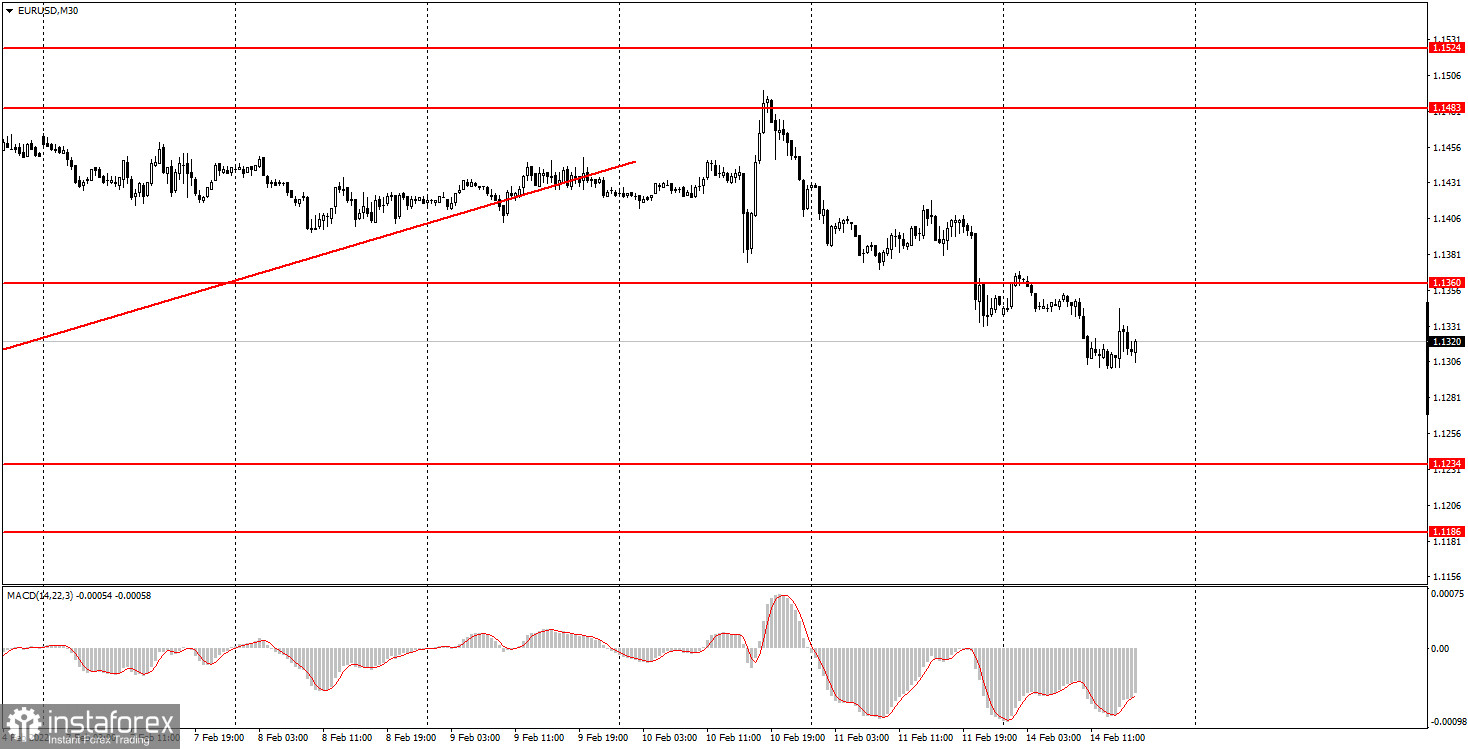Monday's deal analysis:
30M EUR/USD pair chart

The EUR/USD currency pair continued to move downwards on Monday. The level of 1.1360 has been successfully overcome. By themselves, the trading was quite calm, but there is a feeling that the market is tense and panic may begin at any moment. Unfortunately, the very nature of the pair's movement is far from the best right now. For example, on Monday, the price went from a minimum to a maximum of about 70 points, which is not so small, but at the same time, it was constantly adjusted and rolled back. As we said earlier, now the movement seems to be trending, but at the same time, it is very inconvenient for traders. There were no macroeconomic statistics on Monday, but in the morning, it became known that the Fed will hold an unscheduled meeting tonight. Most likely, its results will be announced tomorrow. Nevertheless, at the opening of the US session, the US dollar fell significantly, which can be attributed to the evening event. In addition, the complex geopolitical situation in the world should now be taken into account. The conflict between the United States and Russia is growing, and at any moment war in Ukraine may begin. Of course, we expect that everything will end peacefully, but any possible options should be taken into account. And market participants also do exactly that.
5M chart of the EUR/USD pair
In the 5-minute timeframe, it is visible what we mean by "inconvenient movement". The pair stood still at the beginning of the European trading session, then fell sharply by 45 points, then stood still for several hours again. At the beginning of the American trading session, it rose by 40 points, then gradually declined. That is, within one day, the movements were both trending and flat, and they constantly replaced each other. Naturally, with such a movement, it is very difficult to talk about strong trading signals. Today, only two have been formed, both are not the most accurate. The first sell signal was formed when the price overcame the level of 1.1330, after which it went down about 20 more points and failed to reach the nearest target level. However, at least 20 points down allowed us to place Stop Loss orders at breakeven. The same applies to the second sell signal in the form of a rebound from the level of 1.1330. The price managed to go down again by about 20 points, but could not reach the level of 1.1292. In general, novice players should not have received a loss today, but they are unlikely to have received a profit either.
How to trade on Tuesday:
In the 30-minute timeframe, the upward trend was canceled, as the pair failed to overcome the level of 1.1483, and then consolidated below 1.1360. It is not possible to form a trend line now since there are no two clear reference points. Nevertheless, given the fundamental background, we believe that the pair will continue to fall, which means the growth of the US currency. On the 5-minute TF on February 15, it is recommended to trade by levels 1.1186, 1.1227-1.1234, 1.1279-1.1292, 1.1330, 1.1360-1.1370. When passing 15 points in the right direction, you should set the Stop Loss to breakeven. On Tuesday, the results of the Fed meeting should be known in the States during the day, and the European Union will publish a report on GDP for the fourth quarter in the second assessment. We believe that the European report will have no impact on the pair's movement, but the data from the Fed will be very important.
Basic rules of the trading system:
1) The signal strength is calculated by the time it took to generate the signal (rebound or overcoming the level). The less time it took, the stronger the signal;
2) If two or more trades were opened near any level on false signals (which did not trigger Take-Profit or work out the nearest target level), then all subsequent signals from this level should be ignored;
3) In a flat, any pair can form a lot of false signals or not form them at all. But in any case, at the first signs of a flat, it is better to stop trading;
4) Trade deals are opened in the period between the beginning of the European session and the middle of the American session when all transactions must be closed manually;
5) On a 30-minute TF, signals from the MACD indicator can be traded only if there is good volatility and a trend, which is confirmed by a trend line or a trend channel;
6) If two levels are located too close to each other (from 5 to 15 points), then they should be considered as an area of support or resistance.
What's on the charts:
Price support and resistance levels are the levels that are the targets when opening purchases or sales. Take-Profit levels can be placed near them;
Red lines are channels or trend lines that display the current trend and show in which direction it is preferable to trade now.;
The MACD indicator is a histogram and a signal line, the intersection of which is a signal to enter the market. It is recommended to use it in combination with trend constructions (channels, trend lines).
Important speeches and reports (always contained in the news calendar) can greatly influence the movement of a currency pair. Therefore, during their exit, it is recommended to trade as carefully as possible or exit the market to avoid a sharp price reversal against the previous movement.
Forex beginners should remember that every trade cannot be profitable. The development of a clear strategy and money management are the keys to success in trading over a long period.





















